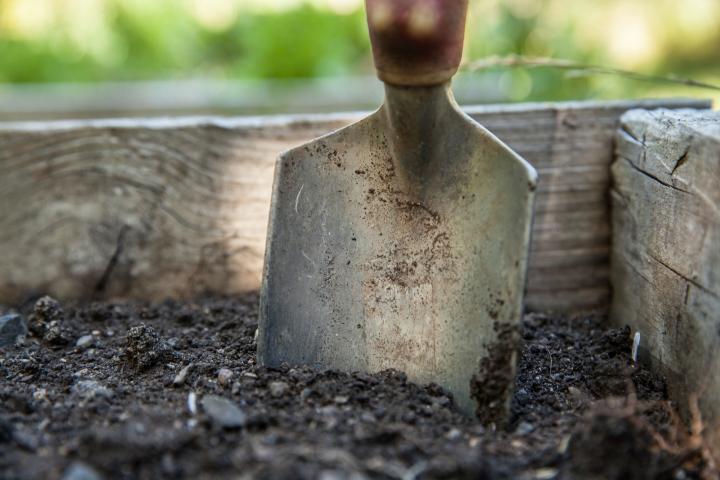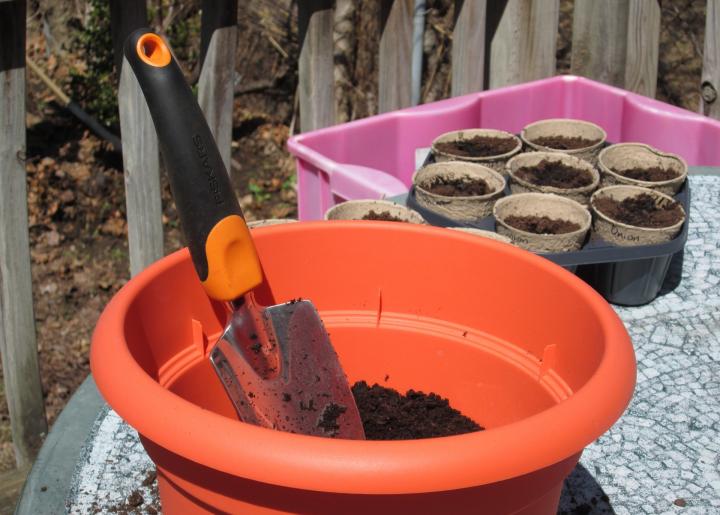Potting Mix For Container Gardening
When gardening with containers or pots, never just use actual soil or dirt. You'll need to use "soilless" potting mix (also called potting soil) for proper drainage and aeration. Here's how to make your own potting soil for container gardens!
Container gardens are on my mind as the winter chill sets in. Containers are great for a number of reasons, namely that they're versatile, space-saving, and allow you to be more efficient in your use of resources. If you have a small garden space or live in an apartment with a balcony or rooftop, containers are for you.
Many gardeners mix up their own potting mixes based on composted bark, coconut coir, perlite, vermiculite, pumice, and other soil additives. A lighter, flufflier soil mix provides the space needed for air circulation, good drainage, and healthy root growth. These soilless are sterile, so there is no chance of introducing pest or disease problems.
How to Make Your Own Potting Soil Mix
For the amount of containers I use in my garden, I learned long ago that it's much cheaper to make my own potting soil and store it in an old trash can, rather than pay for several big sacks of pre-made potting mix. Plus, I can customize the mix for a variety of different plants.
Before we go any further, note that if you only need a few small containers' worth of potting soil, you may actually be better off buying a pre-made mix! Making your own is usually only economical on a large scale or in the long term.

Here are a few things to keep in mind before creating your own mix:
- When it comes to any potting mix, the lighter it is, the better. Loose and porous mixtures not only make a container lighter to move, but they transport water, fertilizer, and air to plant roots more quickly, and allow for good drainage, which is important for container gardening.
- Start with the basic recipe below and then add soil sulfur to lower the pH or lime to raise the pH, according to the needs of your plants. Both additives can typically be found at garden centers. Plants such as lettuce, Russian sage, and marigolds prefer sweet soil with a pH of about 7.5, while others are acid lovers, like ferns, asters, and strawberries. They need a pH of about 5.5 to 6.0. Here's a list of more plants' pH preferences.
- If rapid drainage is needed, as is the case for cacti, succulents, and lavender, add extra sand and perlite.
- If greater moisture retention is needed, as is the case for ferns and woodland flowers (like primrose) add extra vermiculite or coconut coir.
Basic Container Potting Mix Recipe
Ingredients
1 bucket (10 quarts) coconut coir
½ bucket (5 quarts) perlite
½ bucket (5 quarts) vermiculite
½ bucket (5 quarts) screened compost or composted cow manure
2 cups fine sand
2 cups pelleted time-release fertilizer
Instructions
Mix thoroughly. Makes enough to fill two 14-inch tubs or five 12-inch hanging baskets. Double or triple recipe for bigger containers.

How Much Potting Mix Do I Need?
Potting mix is sold by volume (typically measured in quarts), and most pots are measured by their diameter. To translate quarts of mix into various pot sizes, use this quick reference.
Pots & Tubs | |
|---|---|
| Container Size | Amount Needed |
| 8-inch | 3 quarts |
| 10-inch | 6 quarts |
| 12-inch | 8 quarts |
| 14-inch | 12 quarts |
| 16-inch | 20 quarts |
| 20-inch | 24 quarts |
| 24-inch | 28 quarts |
| 30-inch | 72 quarts |
| 36-inch | 96 quarts |
Hanging Baskets | |
| 12-inch | 6 quarts |
| 16-inch | 10 quarts |
Window Boxes | |
| 24 inches by 6 inches | 12 quarts |
| 36 inches by 6 inches | 20 quarts |
Learn More
Wondering when and how to fertilize your containers? Here are some tips.
See our Plant Growing Guides for advice on planting and growing popular vegetables, fruit, and flowers!
Do you make your own potting soil? Share your recipe in the comments below!
Potting Mix For Container Gardening
Source: https://www.almanac.com/make-your-own-potting-soil
Posted by: trantrive1970.blogspot.com

0 Response to "Potting Mix For Container Gardening"
Post a Comment